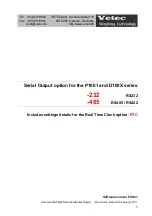
voltage equipment.
Extreme care should be practiced when handling the picture tube. Rough handling may cause it
to implode due to atmospheric pressure. (14.7 lbs per sq. in.). Do not nick or scratch the glass
or subject it to any undue pressure. When handling, usesafety goggles and heavy gloves for
protection. Discharge the picture tube by shorting the anode to chassis ground (not to the
cabinet or to other mounting hardware). When discharging connect cold ground (i.e. dag
ground lead) to the anode with a wellinsulated wire or use a grounding probe.Avoid prolonged
exposure at close range to unshielded areas of the picture tube to prevent exposure to x ray
radiation.
The test picture tube used for servicing the chassis at the bench should incorporate safety
glass and magnetic shielding. The safety glass provide shielding for the tube viewing area
against x ray radiation as well as implosion. The magnetic shieldlimits the x ray radiation
around the bell of the picture tube in addition to the restricting magnetic effects. When using a
picture tube test jig for service, ensure that the jig is capable of handling 50kV without causing
x ray radiation.
Before returning a serviced receiver to the owner, the service technician must thoroughly test
the unit to ensure that is completely safe to operate. Do not use a line isolation transformer
when testing.
Leakage current cold check
Unplug the A.C. cord and connect a jumper between the two plug prongs.Measure the
resistance between the jumpered AC plug and expose metallic parts such as screwheads,
antenna terminals, control shafts, etc. If the exposed metallic part has a returnpath to the
chassis, the reading should be between 240k and 5.2M . If the exposed metallic part does
not have a return path to the chassis, the reading should be infinite.
Leakage current hot check
Plug the AC cord directly into the AC outlet. Do not use an isolation transformer during the
check.
Connect a 1.5k 10 watt resistor in parallel with a 0.15 F capacitor between an exposed
metallic part and ground. Use earth ground, for example a water pipe.
Using a DVM with a 1000 ohms/volt sensitivity or higher, measure the AC potential across the
resistor.
Repeat the procedure and measure the voltage present with all other exposed metallic parts.
Verify that any potential does not exceed 0.75 volt RMS. A leakage current tester (such a
Simpson model 229, Sencore model PR57 or equivalent) may be used in the above procedure, in
which case any current measure must not exceed 0.5 milliampere.If any measurement is out of
the specified limits, there is a possibility of a shock hazard and the receiver must be repaired
and rechecked before it is returned to the customer.
Hot check circuit
3
Summary of Contents for PT-47WX33G
Page 27: ...L887 EXCELDR35V FERRITE BEAD 27 ...
Page 31: ...R073 ERDS2TJ471T RES C 470 J 1 4W 31 ...
Page 35: ...R865 ERJ6GEYJ153V RES M 15K J 1 10W 35 ...
Page 113: ...5 PTV Location of controls 10 ...
Page 124: ...A BOARD 21 ...
Page 125: ...D BOARD 22 ...
Page 126: ...R BOARD VIEW DC BOARD TOP VIEW 23 ...
Page 127: ...DC BOARD BOTTOM VIEW DV BOARD 24 ...
Page 128: ...DG BOARD TOP VIEW DG BOARD BOTTOM VIEW 25 ...
Page 178: ...19 5 Instructional flow for service mode 75 ...
Page 179: ...76 ...
Page 180: ...20 Reference of PDF links color 21 Conductor views 77 ...
Page 182: ...22 2 Video block diagram 23 Schematic diagrams 23 1 Schematic diagrams notes 79 ...
Page 183: ...80 ...
Page 184: ...23 2 Notas de los diagramas esquematicos 81 ...
Page 185: ...82 ...
Page 190: ...87 ...
Page 193: ...90 ...
Page 195: ...92 ...
Page 197: ...94 ...
Page 199: ...96 ...
Page 201: ...98 ...
Page 207: ...Q 104 ...
Page 209: ...Q 106 ...
Page 215: ...112 ...
Page 217: ...114 ...
Page 220: ...117 ...
Page 222: ...119 ...




































